Fusion of galaxies |
Fusion of galaxies | |  Automatic translation Automatic translation | | Updated June 01, 2013 |
Large galaxies grow by attracting small galaxies as they pass nearby. In fact, this practice is common throughout the Universe.
The image cons of the galaxy NGC 1532 that eats the small NGC 1531, illustrates this practice. This beautiful pair of interacting galaxies in the constellation Eridanus is (the river).
It is located more than 50 million light-years away and spans 100,000 light years. The large spiral galaxy NGC 1532 has captured the dwarf galaxy NGC 1531 in its radius of gravitational influence. The small galaxy is trapped in the gravitational force that imposes large galaxy. The unequal struggle eventually merging the small NGC 1531 in NGC 1532. NGC 1532/1531 pair of galaxies is an inseparable and very closely resembles the system of spiral galaxy Whirlpool or the Whirlpool known as the M51 and its companion NGC 5195.
On the right image, the Hubble Space Telescope shows the gravitational power of NGC 5194 drawing its companion NGC 5195. | | 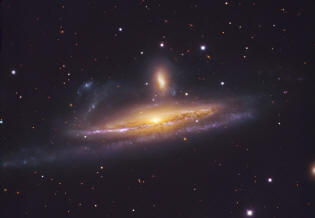 Image: The galaxy NGC 1532 NGC 1532/1531 which devours the small NGC 1531. Image ESO / Danish 1.5m telescope at La Silla, Chile - 2008. | | 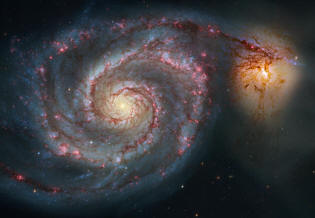 Image: The Whirlpool galaxy NGC 5194 or the Tourbillon 60 000 light years in diameter is also known as the M51.
It absorbs NGC 5195, his companion on the right. credit: Hubble. |
Two galaxies tear their prey | | | | |
Usually, there are two galaxies aspire themselves y mutually entangle. Image below shows three cons Hubble galaxies that are struggling to survive, NGC 7173, NGC 7174 and NGC 7176 that are part of the Hickson Compact Group 90. You can see from the picture cons, elliptical galaxies, NGC 7173 (left) and NGC 7176 (bottom) with very little dust and gas, while NGC 7174 (upper right) is a galaxy spiral-rich gas and dust. The two monsters by drawing elliptical tear gas and dust in NGC 7174 with such force of gravity as the stars are ejected out of the battlefield.
The galactic center of NGC 7174 is shredded and drawn toward the galaxy NGC 7173 to the left of the image. The forces of attraction, which faces the galaxy NGC 7174, are daunting.
The three galaxies will eventually merge to form another star system, another larger galaxy that give birth to other stars with the huge amount of gas and dust stored in the merger.
These new stars, will millions of years to catch fire. | | NB: The Hickson Compact Group 90 comprises 16 galaxies with those of the image. It lies about 100 million light years from Earth in the direction of the constellation of the Southern Fish (Piscis Austrinus). Image: This image is not impressive at first glance but if one looks carefully, one sees what was originally a beautiful spiral galaxy with a disk vertical well, get screwed by her neighbors left and bottom.
NGC 7173 is on the left and NGC 7176 is low, for NGC 7174 on the right, we see that it undergoes gravitational forces destructive of its neighbors.
Credit NASA / ESA / Hubble. | | 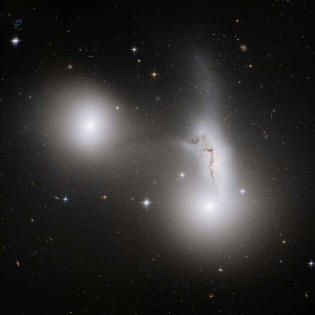 |
Fusion of NGC 4038 and NGC 4039 | | | | |
There are about 500 million years, the two galaxies NGC 4038 and 4039 began to collide.
Here they are interacting, connected by a bridge of material from which flow an outbreak of blue stars, wrapped in giant clouds of dust.
They now form one of the most famous couples galaxy, called the Antennae (the Antennae). This pair of interacting galaxies is in the constellation of the Raven. In 2004 and 2005, the Hubble telescope, with its new high-resolution camera photographed the shock ACS cosmic runs at 68 million light years.
This beautiful photo shows with unprecedented clarity, the many regions of star formation (pink and blue image) appeared following the compression of interstellar gas generated by the encounter. | | Already in 1997, the space telescope has photographed the central antennas, but in 2005, astronomers are able to provide details of the giant star clusters, including a hundred of them should survive only as globular clusters. Image: the couple galactic Antennae, there are about 500 million years that the two galaxies NGC 4038 and 4039 began to collide.
Picture taken by the ACS camera of the Hubble telescope. | | 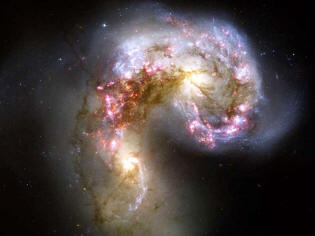 |
Fusion of the Mice Galaxies | | | | |
These two mighty galaxies and NGC4676A NGC76B, attract towards one another in order to merge.
They are known as the "Mouse galaxies or Mice Galaxies" because of their long tails subject to the tidal force. Each of these spiral galaxies interact gravitationally on each other and the process will probably continue until they merge to form a single galaxy. The long blue tails, in contrast to the brown cores of galaxies. This slow merger that lasted several hundred million years, takes place in the radial velocity of approximately 6 600 km/s.
NGC 4676 lies about 290 million light years from Earth towards the constellation Coma Berenices "Coma Berenices" and these galaxies are members of the Coma cluster of galaxies. | | Image: This image NGC4676A galaxies (right) and NGC76B (left) in the process of fusion, was taken by the camera, the Advanced Camera for Surveys "of the Hubble Space Telescope.
The increased sensitivity of this new camera to photograph distant galaxies scattered across the image.
Credit: ACS Science & Engineering Team, Hubble Space Telescope, NASA | | 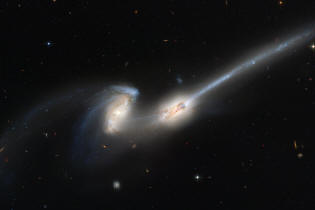 |
Cartwheel galaxy crossed by another | | | | |
The Cartwheel Galaxy (also known as the ESO 350-40) is a lenticular galaxy or annular located about 500 million light years away in the constellation Sculptor in the southern hemisphere. The cartwheel shape of this galaxy is the result of a violent galactic collision that occurred there are about 200 million years.
A small galaxy passed through the heart of a large disk galaxy, and produced this gigantic shock wave, which propagated the surrounding gas and dust in the galaxy, much like the ripples of water produced when a stone is thrown into a lake.
The Cartwheel galaxy is now surrounded by a bluish ring of 150 000 light years in diameter, composed of bright young stars. Moving at high speed of the shock wave, a compressed gas and dust, which has fostered the birth of stars that light up now, the edge of the wave. In the image, regions of star formation are shown in blue. The outer ring of the galaxy, is 1.5 times the size of our Milky Way. It can be seen in this picture, the galaxy is now back as a normal spiral galaxy, with galactic arms that form again from the central core. | | This galaxy was a galaxy similar to the Milky Way, before it undergoes the collision.
This is a celestial object of the most remarkable class of ring galaxies.
Star formation in the rings, like the Cartwheel Galaxy, promotes the formation of stars of large size and very bright.
When these massive stars explode as a supernova, it remains in their hearts, a neutron star or black hole. Some of these neutron stars and black holes attract matter from nearby stars and become powerful sources of X-rays Cartwheel contains an unusually high number of these black holes X-ray sources, because many formed massive stars have formed in the ring of the galaxy.
This image was produced with data from Hubble and adjusted using the open source software FITS Liberator 3, which was developed at ST-ECF.
Judicious use of this tool has allowed the original Hubble observations, to obtain details of the Cartwheel galaxy. NB: Hubble images of high resolution ESA. | | 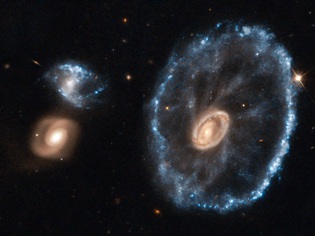 Image: The image retired of this cosmic event, shows the Cartwheel galaxy also known as the ESO 350-40. Image Hubble telescope NASA / ESA Space. |
Pending fusion in ARP 148 | | | | |
Arp 148 is the result of an amazing encounter between two galaxies, one ring-shaped and the other cigar-shaped.
The collision between two galaxies produced a shockwave effect, that is, at first, the mater is drawn toward the center and is propelled violently outward. This mater will form a ring in which millions of stars will be born by the concentration of dust and gas.
This beautiful image fusion represents the cosmic phenomenon well underway, a collision of galaxies. Infrared observations reveal a heavily obscured that appears as a dark band of dust in the nucleus in optical light.
The object Arp 148 is nicknamed "Mayall's object" and is located in the constellation Ursa Major, about 500 million light-years.
This pair of interacting galaxies is included in the catalog of galaxies Arp with number 148.
This image is part of a large collection of 59 images of merging galaxies taken by the Hubble Space Telescope and released on the occasion of his 18th birthday April 24, 2008. | | The object Mayall (Arp 148) was discovered by Nicholas U. Mayall Observatory licking March 13, 1940, using the Crossley reflector.
At its first observation, the object Mayall has been described as one nebulous particular shape of a question mark, then as a galaxy ARP 148 and now represents the collision of two galaxies, which formed a new object consisting of a ring-shaped galaxy with a tail that emerges. Image: Image Credit: NASA, ESA, the Hubble Heritage (STScI / AURA) -ESA/Hubble Collaboration, and A. Evans (University of Virginia, Charlottesville / NRAO / Stony Brook University) | | 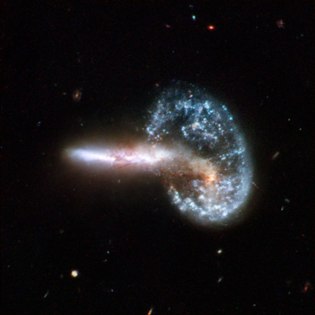 |
Advanced Blending in the galaxy NGC 6240 | | | | |
The galaxy NGC 6240 offers a rare glimpse of a cosmic catastrophe in its terminal phase. In reality, the galaxy NGC 6240 is a pair of extremely bright galaxies in the wavelength of infrared.
They are located 400 million light years away in the constellation Ophiuchus.
NGC 6240 is the result of a collision of two small galaxies that has produced a galaxy more than 2 cores, irregular type. We still see the two outer rings.
This fusion of distorted galaxies, it lags behind, a tail of stars, gas and dust as well as filaments of star formation.
At the center of NGC 6240 two supermassive black holes are orbiting around each other, separated by only 3000 light years. | | These two supermassive black holes hosted in galactic nuclei will eventually merge into one also, in some form for hundreds of millions of years, an even more massive black hole. Image: Composite image of galaxy NGC 6240.
This spectacular image of galaxies merging is a composite manifold. The infrared emission from dust has been recorded by the Spitzer Space Telescope, Hubble has captured while the light of stars visible in shades of green and blue.
The view stretches over 300,000 light years, which is an estimate of the size of NGC 6240.
Credit: NASA / JPL-Caltech / STScI-ESA / S. Bush, et al. (Harvard-Smithsonian CfA) | | 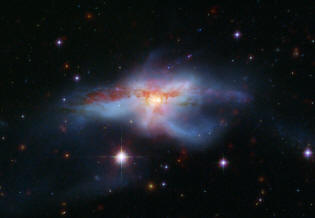 |
Complete fusion of the galaxy NGC 2623 | | | | |
NGC 2623 is the result of a galactic merger.
In 2007, astronomers have photographed this galaxy, in high resolution using the Hubble Space Telescope.
The analysis of Hubble images and those taken in infrared Spitzer Space Observatory, in XMM Newton X-ray and ultraviolet by GALEX, shows that NGC 2623 is composed of two spiral galaxies that have merged.
The merger closed, the initial nuclei of two galaxies have merged themselves into a single nucleus.
The process of star formation continues around the centrally located nucleus and along the galactic arms stretched horizontally on both sides. | | Oddly, upper left of the galactic center, far from the nucleus, yet we see the brilliant blue star clusters in formation. NGC 2623, also known as Arp 243, covers about 50 000 light years and lies about 250 million light-years away in the constellation Cancer. Image: Image of the galaxy NGC 2623, taken by the Hubble Space Telescope in 2007. The view stretches over 50 000 light years, which is an estimate of the size of NGC 6240.
Credit: NASA, ESA and A. Evans (Stony Brook), and al. | | 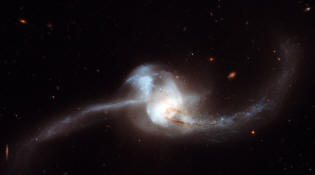 |
Colliding galaxies ARP 142 | | | | |
This collision of galaxies shows the reconciliation of two interacting galaxies. This pair of galaxies disturbed by gravity is collectively called Arp 142. Pictured on a striking spiral galaxy of star formation NGC 2936 (top) with its elliptical companion NGC 2937 (bottom). The orbits of stars in the spiral galaxy are extremely distorted due to gravitational tidal interactions with other elliptical galaxy.
The long elongated tail of NGC 2936, attracted by the gravitational force of NGC 2937, and compresses the gas and dust give rise to blue stars can be seen form the approach of the elliptical galaxy. The longest river in reddish dust that can be seen stretching across the galaxy from the top is sucked out of the center of the galaxy and dark veins stand out against the bright stars of the rest of the disk and the galactic core. The elliptical galaxy NGC 2937 is a huge galaxy of stars old brown that contains little gas and dust. Indeed, the stars contained in the galaxy are mostly old, as evidenced by their reddish color. | | You do not see young blue stars. The meeting of these two galaxies is to the advantage of the elliptical galaxy NGC 2937, which it did not seem perturbed by the gravitational effect of its neighbor. Image: The striking collision of two galaxies, called ARP 142, image taken by the Hubble telescope. Image Credit: NASA / ESA / Hubble Heritage Team. | | 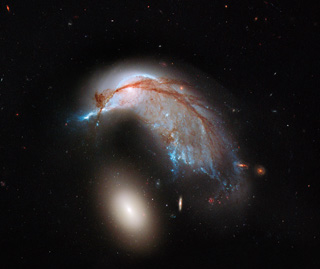 |
 Automatic translation
Automatic translation












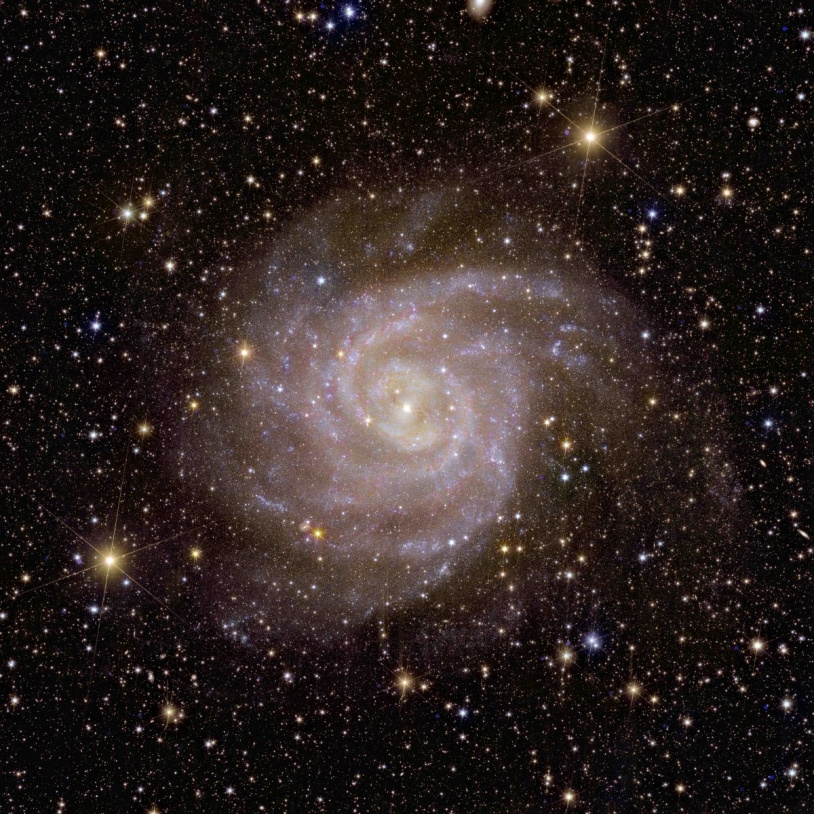 The hidden galaxy, one of Euclid's first images
The hidden galaxy, one of Euclid's first images
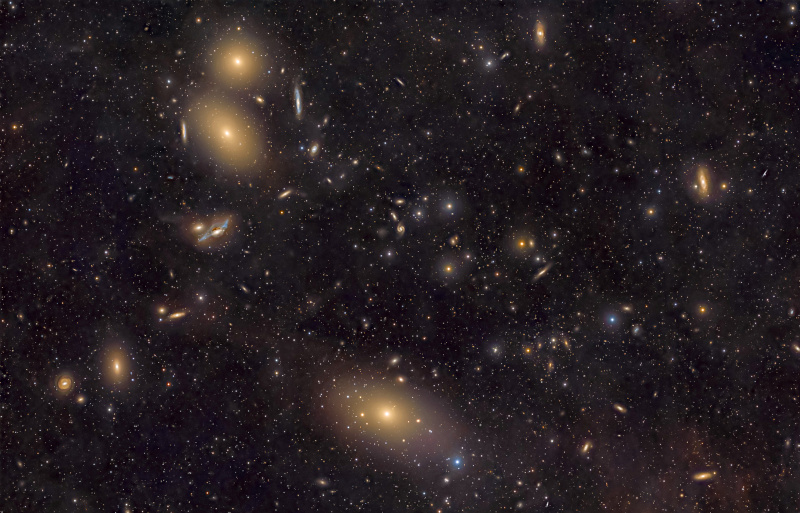 The Virgo Cluster spans approximately three Full Moons
The Virgo Cluster spans approximately three Full Moons
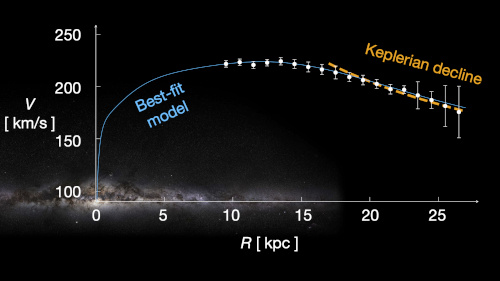 Where did the dark matter in our Galaxy go?
Where did the dark matter in our Galaxy go?
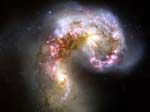 Merging galaxies and black holes
Merging galaxies and black holes
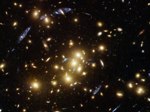 Mirages created by gravitational lenses
Mirages created by gravitational lenses
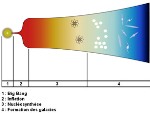 Mystery of the Big Bang, the problem of the horizon
Mystery of the Big Bang, the problem of the horizon
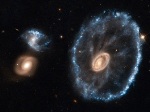 Cartwheel Galaxy Cosmic Event
Cartwheel Galaxy Cosmic Event
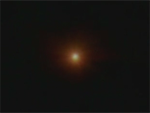 The first second of our history
The first second of our history
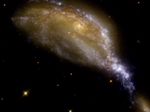 A small galaxy tears apart the large NGC 6745
A small galaxy tears apart the large NGC 6745
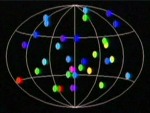 The mystery of gamma bursts
The mystery of gamma bursts
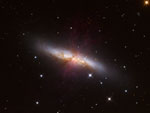 The Cigar Explosion
The Cigar Explosion
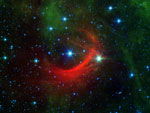 Shockwaves
Shockwaves
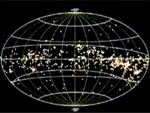 Gould's belt, a stellar fireworks display
Gould's belt, a stellar fireworks display
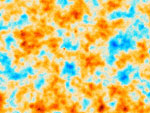 Recombination in cosmology
Recombination in cosmology
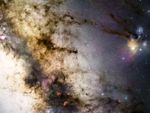 Journey to the center of our galaxy
Journey to the center of our galaxy
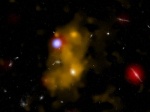 Lyman-alpha bubbles
Lyman-alpha bubbles
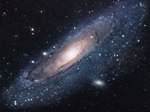 Andromeda in the ultraviolet
Andromeda in the ultraviolet
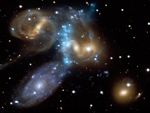 The most beautiful galaxy clusters
The most beautiful galaxy clusters
 Tinkerbell merger of three galaxies
Tinkerbell merger of three galaxies
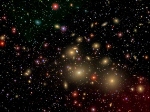 A gigantic black hole
A gigantic black hole
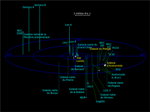 Enigma of coplanar galaxies
Enigma of coplanar galaxies
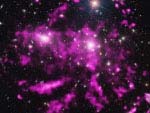 The cluster of galaxies Coma in its soup
The cluster of galaxies Coma in its soup
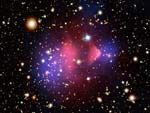 The cannonball, proof of dark matter
The cannonball, proof of dark matter
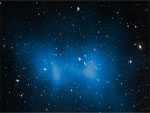 El Gordo galaxy cluster
El Gordo galaxy cluster
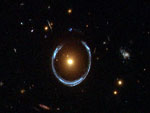 Einstein ring and cross
Einstein ring and cross
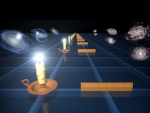 How to measure distances in the Universe?
How to measure distances in the Universe?
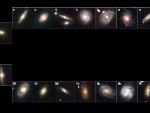 The Hubble sequence and types of galaxies
The Hubble sequence and types of galaxies
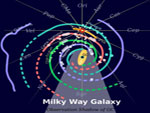 The spiral shape of the galactic arms
The spiral shape of the galactic arms
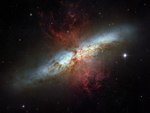 Even more stars, the Cigar galaxy
Even more stars, the Cigar galaxy
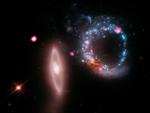 The Universe of X-rays
The Universe of X-rays
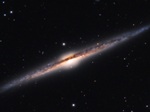 The most beautiful galaxies
The most beautiful galaxies
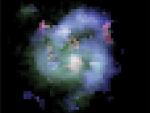 The oldest galaxies in the universe
The oldest galaxies in the universe
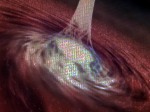 Quasars the nuclei of galaxies
Quasars the nuclei of galaxies
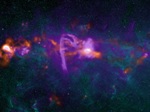 Sagittarius A black hole at the center of our Galaxy
Sagittarius A black hole at the center of our Galaxy
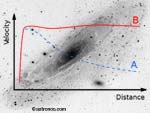 The MOND theory and its contradiction
The MOND theory and its contradiction
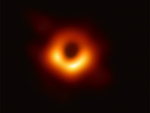 The first image of a black hole
The first image of a black hole
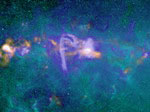 Central area of the Milky Way
Central area of the Milky Way
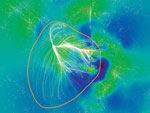 Laniakea, our supercluster of galaxies
Laniakea, our supercluster of galaxies